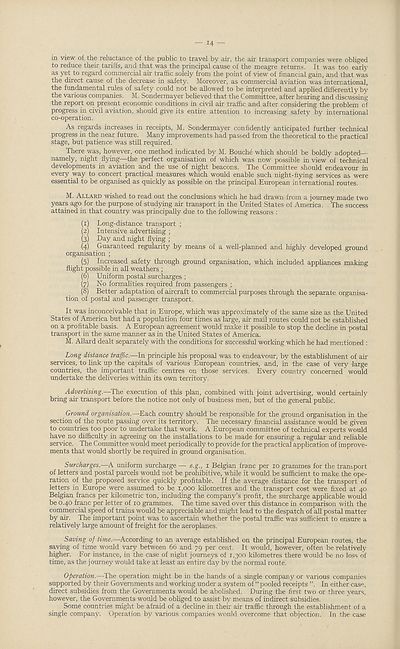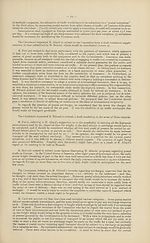Communications and transit > Air transport co-operation committee : minutes of the first session : held at Geneva from July 8th to 12th, 1930
(14)
Download files
Complete book:
Individual page:
Thumbnail gallery: Grid view | List view

14 —
in view of the reluctance of the public to travel by air, the air transport companies were obliged
to reduce their tariffs, and that was the principal cause of the meagre returns. It was too early
as yet to regard commercial air traffic solely from the point of view* of financial gain, and that was
the direct cause of the decrease in safety. Moreover, as commercial aviation wTas international,
the fundamental rules of safety could not be allowed to be interpreted and applied differently by
the various companies. M. Sondermayer believed that the Committee, after hearing and discussing
the report on present economic conditions in civil air traffic and after considering the problem of
progress in civil aviation, should give its entire attention to increasing safety by international
co-operation.
As regards increases in receipts, M. Sondermayer confidently anticipated further technical
progress in the near future. Many improvements had passed from the theoretical to the practical
stage, but patience was still required.
There was, however, one method indicated by M. Bouche which should be boldly adopted—
namely, night flying—the perfect organisation of which was now possible in view of technical
developments in aviation and the use of night beacons. The Committee should endeavour in
every way to concert practical measures which would enable such night-flying services as were
essential to be organised as quickly as possible on the principal European international routes.
M. Allard wished to read out the conclusions which he had drawn from a journey made two
years ago for the purpose of studying air transport in the United States of America. The success
attained in that country was principally due to the following reasons :
(1) Long-distance transport ;
(2) Intensive advertising ;
(3) Day and night flying ;
(4) Guaranteed regularity by means of a well-planned and highlv developed ground
organisation ;
(5) Increased safety through ground organisation, which included appliances making
flight possible in all weathers ;
(6) Uniform postal surcharges ;
(7) No formalities required from passengers ;
(8) Better adaptation of aircraft to commercial purposes through the separate organisa¬
tion of postal and passenger transport.
It was inconceivable that in Europe, which was approximately of the same size as the United
States of America but had a population four times as large, air mail routes could not be established
on a profitable basis. A European agreement would make it possible to stop the decline in postal
transport in the same manner as in the United States of America.
M. Allard dealt separately with the conditions for successful working which he had mentioned :
Long distance traffic.—In principle his proposal was to endeavour, by the establishment of air
services, to link up the capitals of various European countries, and, in the case of very large
countries, the important traffic centres on those services. Every country concerned would
undertake the deliveries within its own territory.
Advertising.—The execution of this plan, combined with joint advertising, would certainly
bring air transport before the notice not only of business men, but of the general public.
Ground organisation.—Each country should be responsible for the ground organisation in the
section of the route passing over its territory. The necessary financial assistance would be given
to countries too poor to undertake that work. A European committee of technical experts would
have no difficulty in agreeing on the installations to be made for ensuring a regular and reliable
service. The Committee would meet periodically to provide for the practical application of improve¬
ments that would shortly be required in ground organisation.
Surcharges.—A uniform surcharge — e.g., 1 Belgian franc per 10 grammes for the transport
of letters and postal parcels would not be prohibitive, while it would be sufficient to make the ope¬
ration of the proposed service quickly profitable. If the average distance for the transport of
letters in Europe were assumed to be 1,000 kilometres and the transport cost were fixed at 40
Belgian francs per kilometric ton, including the company’s profit, the surcharge applicable would
be 0.40 franc per letter of 10 grammes. The time saved over this distance in comparison with the
commercial speed of trains would be appreciable and might lead to the despatch of all postal matter
by air. The important point wTas to ascertain whether the postal traffic was sufficient to ensure a
relatively large amount of freight for the aeroplanes.
/
Saving of time.—According to an average established on the principal European routes, the
saving of time would vary between 66 and 79 per cent. It would, however, often be relatively
higher. For instance, in the case of night journeys of 1,300 kilometres there would be no loss of
time, as the journey would take at least an entire day by the normal route.
Operation.—The operation might be in the hands of a single company or various companies
supported by their Governments and working under a system of “pooled receipts ”. In either case,
direct subsidies from the Governments w'ould be abolished. During the first two or three years,
however, the Governments would be obliged to assist by means of indirect subsidies.
Some countries might be afraid of a decline in their air traffic through the establishment of a
single company. Operation by various companies would overcome that objection. In the case
in view of the reluctance of the public to travel by air, the air transport companies were obliged
to reduce their tariffs, and that was the principal cause of the meagre returns. It was too early
as yet to regard commercial air traffic solely from the point of view* of financial gain, and that was
the direct cause of the decrease in safety. Moreover, as commercial aviation wTas international,
the fundamental rules of safety could not be allowed to be interpreted and applied differently by
the various companies. M. Sondermayer believed that the Committee, after hearing and discussing
the report on present economic conditions in civil air traffic and after considering the problem of
progress in civil aviation, should give its entire attention to increasing safety by international
co-operation.
As regards increases in receipts, M. Sondermayer confidently anticipated further technical
progress in the near future. Many improvements had passed from the theoretical to the practical
stage, but patience was still required.
There was, however, one method indicated by M. Bouche which should be boldly adopted—
namely, night flying—the perfect organisation of which was now possible in view of technical
developments in aviation and the use of night beacons. The Committee should endeavour in
every way to concert practical measures which would enable such night-flying services as were
essential to be organised as quickly as possible on the principal European international routes.
M. Allard wished to read out the conclusions which he had drawn from a journey made two
years ago for the purpose of studying air transport in the United States of America. The success
attained in that country was principally due to the following reasons :
(1) Long-distance transport ;
(2) Intensive advertising ;
(3) Day and night flying ;
(4) Guaranteed regularity by means of a well-planned and highlv developed ground
organisation ;
(5) Increased safety through ground organisation, which included appliances making
flight possible in all weathers ;
(6) Uniform postal surcharges ;
(7) No formalities required from passengers ;
(8) Better adaptation of aircraft to commercial purposes through the separate organisa¬
tion of postal and passenger transport.
It was inconceivable that in Europe, which was approximately of the same size as the United
States of America but had a population four times as large, air mail routes could not be established
on a profitable basis. A European agreement would make it possible to stop the decline in postal
transport in the same manner as in the United States of America.
M. Allard dealt separately with the conditions for successful working which he had mentioned :
Long distance traffic.—In principle his proposal was to endeavour, by the establishment of air
services, to link up the capitals of various European countries, and, in the case of very large
countries, the important traffic centres on those services. Every country concerned would
undertake the deliveries within its own territory.
Advertising.—The execution of this plan, combined with joint advertising, would certainly
bring air transport before the notice not only of business men, but of the general public.
Ground organisation.—Each country should be responsible for the ground organisation in the
section of the route passing over its territory. The necessary financial assistance would be given
to countries too poor to undertake that work. A European committee of technical experts would
have no difficulty in agreeing on the installations to be made for ensuring a regular and reliable
service. The Committee would meet periodically to provide for the practical application of improve¬
ments that would shortly be required in ground organisation.
Surcharges.—A uniform surcharge — e.g., 1 Belgian franc per 10 grammes for the transport
of letters and postal parcels would not be prohibitive, while it would be sufficient to make the ope¬
ration of the proposed service quickly profitable. If the average distance for the transport of
letters in Europe were assumed to be 1,000 kilometres and the transport cost were fixed at 40
Belgian francs per kilometric ton, including the company’s profit, the surcharge applicable would
be 0.40 franc per letter of 10 grammes. The time saved over this distance in comparison with the
commercial speed of trains would be appreciable and might lead to the despatch of all postal matter
by air. The important point wTas to ascertain whether the postal traffic was sufficient to ensure a
relatively large amount of freight for the aeroplanes.
/
Saving of time.—According to an average established on the principal European routes, the
saving of time would vary between 66 and 79 per cent. It would, however, often be relatively
higher. For instance, in the case of night journeys of 1,300 kilometres there would be no loss of
time, as the journey would take at least an entire day by the normal route.
Operation.—The operation might be in the hands of a single company or various companies
supported by their Governments and working under a system of “pooled receipts ”. In either case,
direct subsidies from the Governments w'ould be abolished. During the first two or three years,
however, the Governments would be obliged to assist by means of indirect subsidies.
Some countries might be afraid of a decline in their air traffic through the establishment of a
single company. Operation by various companies would overcome that objection. In the case
Set display mode to:
![]() Universal Viewer |
Universal Viewer | ![]() Mirador |
Large image | Transcription
Mirador |
Large image | Transcription
Images and transcriptions on this page, including medium image downloads, may be used under the Creative Commons Attribution 4.0 International Licence unless otherwise stated. ![]()
| League of Nations > Communications and transit > Air transport co-operation committee : minutes of the first session : held at Geneva from July 8th to 12th, 1930 > (14) |
|---|
| Permanent URL | https://digital.nls.uk/194043529 |
|---|
| Shelfmark | LN.VIII |
|---|
| Description | Over 1,200 documents from the non-political organs of the League of Nations that dealt with health, disarmament, economic and financial matters for the duration of the League (1919-1945). Also online are statistical bulletins, essential facts, and an overview of the League by the first Secretary General, Sir Eric Drummond. These items are part of the Official Publications collection at the National Library of Scotland. |
|---|---|
| Additional NLS resources: |
|

